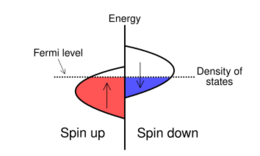Physics:Stoner criterion
The Stoner criterion is a condition to be fulfilled for the ferromagnetic order to arise in a simplified model of a solid. It is named after Edmund Clifton Stoner.
Stoner model of ferromagnetism
Ferromagnetism ultimately stems from Pauli exclusion. The simplified model of a solid which is nowadays usually called the Stoner model, can be formulated in terms of dispersion relations for spin up and spin down electrons,
- [math]\displaystyle{ E_\uparrow(k)=\epsilon(k)-I\frac{N_\uparrow-N_\downarrow}{N},\qquad E_\downarrow(k)=\epsilon(k)+I\frac{N_\uparrow-N_\downarrow}{N}, }[/math]
where the second term accounts for the exchange energy, [math]\displaystyle{ I }[/math] is the Stoner parameter, [math]\displaystyle{ N_\uparrow/N }[/math] ([math]\displaystyle{ N_\downarrow/N }[/math]) is the dimensionless density[note 1] of spin up (down) electrons and [math]\displaystyle{ \epsilon(k) }[/math] is the dispersion relation of spinless electrons where the electron-electron interaction is disregarded. If [math]\displaystyle{ N_\uparrow +N_\downarrow }[/math] is fixed, [math]\displaystyle{ E_\uparrow(k), E_\downarrow(k) }[/math] can be used to calculate the total energy of the system as a function of its polarization [math]\displaystyle{ P=(N_\uparrow-N_\downarrow)/N }[/math]. If the lowest total energy is found for [math]\displaystyle{ P=0 }[/math], the system prefers to remain paramagnetic but for larger values of [math]\displaystyle{ I }[/math], polarized ground states occur. It can be shown that for
- [math]\displaystyle{ ID(E_{\rm F}) \gt 1 }[/math]
the [math]\displaystyle{ P=0 }[/math] state will spontaneously pass into a polarized one. This is the Stoner criterion, expressed in terms of the [math]\displaystyle{ P=0 }[/math] density of states[note 1] at the Fermi energy [math]\displaystyle{ D(E_{\rm F}) }[/math].
A non-zero [math]\displaystyle{ P }[/math] state may be favoured over [math]\displaystyle{ P=0 }[/math] even before the Stoner criterion is fulfilled.
Relationship to the Hubbard model
The Stoner model can be obtained from the Hubbard model by applying the mean-field approximation. The particle density operators are written as their mean value [math]\displaystyle{ \langle n_i\rangle }[/math] plus fluctuation [math]\displaystyle{ n_i-\langle n_i\rangle }[/math] and the product of spin-up and spin-down fluctuations is neglected. We obtain[note 1]
- [math]\displaystyle{ H = U \sum_i [n_{i,\uparrow} \langle n_{i,\downarrow}\rangle +n_{i,\downarrow} \langle n_{i,\uparrow}\rangle - \langle n_{i,\uparrow}\rangle \langle n_{i,\downarrow}\rangle] - t \sum_{\langle i,j\rangle,\sigma} (c^{\dagger}_{i,\sigma}c_{j,\sigma}+h.c). }[/math]
With the third term included, which was omitted in the definition above, we arrive at the better-known form of the Stoner criterion
- [math]\displaystyle{ D(E_{\rm F})U \gt 1. }[/math]
Notes
- ↑ 1.0 1.1 1.2 Having a lattice model in mind, [math]\displaystyle{ N }[/math] is the number of lattice sites and [math]\displaystyle{ N_\uparrow }[/math] is the number of spin-up electrons in the whole system. The density of states has the units of inverse energy. On a finite lattice, [math]\displaystyle{ \epsilon(k) }[/math] is replaced by discrete levels [math]\displaystyle{ \epsilon_i }[/math] and then [math]\displaystyle{ D(E)=\sum_i \delta(E-\epsilon_i) }[/math].
References
- Stephen Blundell, Magnetism in Condensed Matter (Oxford Master Series in Physics).
- Teodorescu, C. M.; Lungu, G. A. (November 2008). "Band ferromagnetism in systems of variable dimensionality". Journal of Optoelectronics and Advanced Materials 10 (11): 3058–3068. http://joam.inoe.ro/download.php?idu=1752. Retrieved 24 May 2014.
- Stoner, Edmund Clifton (April 1938). "Collective electron ferromagnetism". Proc. R. Soc. Lond. A 165 (922): 372–414. doi:10.1098/rspa.1938.0066. Bibcode: 1938RSPSA.165..372S.
 |


